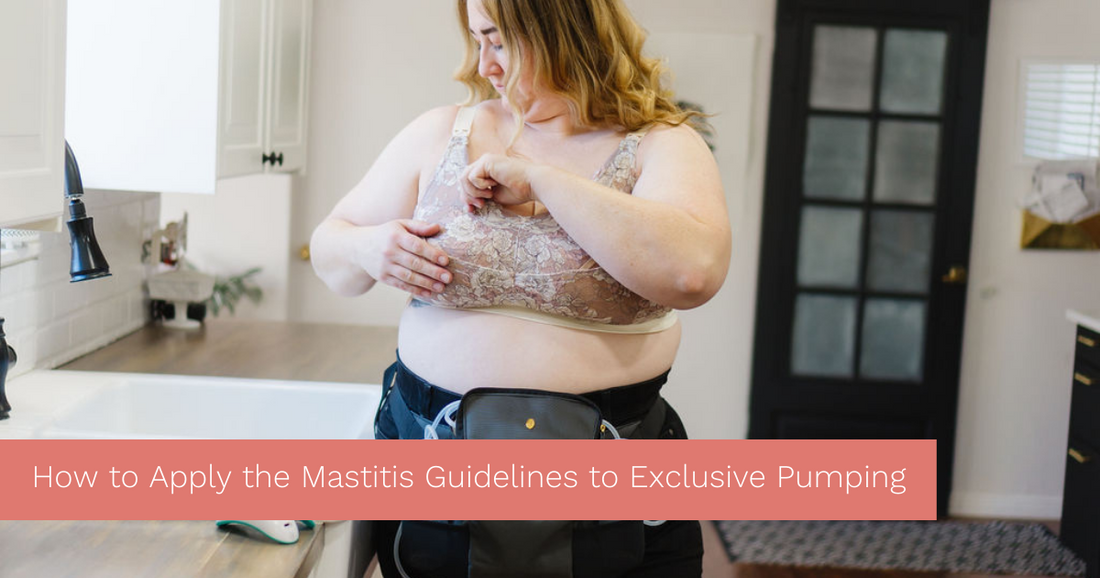How to Apply the Mastitis Guideines to Exclusive Pumping
Mommy Care Team
In 2022 the Academy of Breastfeeding Medicine or ABM published new information about Mastitis, and updated their previous treatment guidelines from 2014. Over the past eight years scientific research has changed our understanding of what mastitis is, and helped us learn better treatment methodologies. We get excited over any research in this space, so to see new informed guidelines that will help save countless breastfeeding journeys has us in a tizzy. Let’s take a look at pumping and the latest mastitis guidelines from the ABM.
In 2014 it seems the goal of care for a patient with mastitis was to keep the milk flowing. Treatment methodologies included pumping, massage, heat, and continued feeding from the affected breast. Research has shown that some of these can compound the inflammation that either leads to or results from mastitis.
How to Apply the New Guidelines for the Treatment of Mastitis for Pumping Moms
These new guidelines have been making the rounds on social media like Instagram, but if you’re a pumping or exclusive pumping mom there isn’t much information to help you. We’ve worked with an experienced lactation professional to help fill the gaps.
Full breast tissue may appear or feel lumpy. Sometimes this appearance can lead people to assume that there is a clog causing the mastitis. However, this is not the case. Often mastitis happens due to one type of infection or other.
Feed Your Baby Not Your Freezer
Previous guidelines instructed moms to feed and pump in order to clear a clog which might have been the cause of mastitis. Research has shown that there are a number of different situations that can cause this painful inflammation and infection.
Feeding and pumping frequently might have helped to clear a clog but in the meantime they send signals to mom’s body to increase milk production. This can actually make things worse for mom, causing painful engorgement. The new guideline has been amended and instructs moms to feed on demand rather than with the goal of emptying your breast. And it has specific instructions for avoiding a pump.
Again, the thought is that breastfeeding moms would use a pump to clear the clog. They are not thinking of all of the moms that express milk to feed their little ones. If you pump and experience mastitis, continue pumping as normal so as not to increase your supply. If you pump to build a freezer stash, consider reducing the number of pump sessions until the mastitis has cleared.
No More Massage
Massage is believed to help mobilize a clog and help to clear it from your breast. Previously, moms were instructed to use massage as a treatment for mastitis. Whether the cause in your current case is a clog or other infection, deep tissue massages actually cause more inflammation. Inflamed breasts are painful. There’s no longer a need to endure the pain if you are trying to clear up mastitis. The guidelines now instruct moms to avoid massagers and do not use massage.
Pumping moms often use massage to help move milk through their breast tissue and aid in expression. Massagers like those from our friends at La Vie should be okay to continue to use as normal. IE don’t use these aggressively in an attempt to clear a clogged duct.
Limit Breast Pump Usage
Yup, there’s this one. The reason they are advising that moms limit the usage of breast pumps is two-fold. We covered the accidental increase in your breast milk supply above. Some moms worry that their milk during mastitis is unsafe to feed their baby. The infection is in your breast tissue, not your milk. Unless instructed by your doctor, continue to feed your baby.
A third reason is that biological nursing creates a bacterial feedback loop. Nursing creates a balance of bacteria as it is transferred from your baby’s mouth to your nipples. In pumping, you don’t get this exchange so it is thought to put moms at increased risk for developing mastitis.
It's a good thing that this isn't the only way we exchange good and bad bacteria with our babies. Pumping moms still kiss, snuggle, and share bacteria with our babies throughout the day. In our day to day experience we have yet to see a peer reviewed article proving that the bacterial exchange in nursing is the only cause of the predisposition for dysbiosis discussed in the guidelines.
The fourth reason that breast pumps are shunned in the new guidelines is that misuse can lead to nipple trauma. If you pump frequently or exclusively pump, there is a good chance that you have learned the causes for nipple trauma or already worked through them. If not, you can check out this post for more information.
Nothing Extra
Other new information that has come out of these updated guidelines is to avoid anything additionally like nipple shields, epsom soaks, and castor oil. Nipple shields can restrict milk flow leading to engorgement. Soaks are thought to further irritate nipples or already impacted tissue.
Avoid cleaning your nipples with anything other than gentle or mild soap during your daily shower or bath. Cleaning solutions or harsh soaps can do more harm than good and there is no real benefit from additional cleaning.
Also, there is no need to do any additional sterilization of your pump parts. The keyword here is additional. Follow your normal cleaning and pumping routine. If you have questions, reach out to a lactation professional for more informed direction.
If you experience milk blebs as a result of your current infection, treat them as you normally would. Do not pop, or manually try to remove the blockage as it can create further opportunity for infection.
Decrease Inflammation
Consult a medical professional and work with them to reduce the swelling association with mastitis. They may recommend acetaminophen to medically reduce swelling. Heat can cause additional swelling so avoid warm compresses. Using cooling compresses may also help to further reduce swelling.
Consult a Medical Professional
Mastitis can be seriously painful and if left untreated, it can become dangerous. Consult a medical professional if you suspect that painful swelling might be something more than a clogged duct. In some cases, you require a prescribed antibiotic, or even an ultrasound treatment.
Perinatal Mood and Anxiety Disorders
The guidelines explain that moms who experience complications with “breastfeeding” (biological nursing) have a higher rate of developing PMADs. It goes on to explain that moms who experience anxiety or depression have a higher rate of mastitis symptoms.
If you’re here, and exclusively pumping, there is a good chance that you have processed or are processing emotions like grief over your breastfeeding journey. If you do not feel like yourself, feel lost, or experience intrusive thoughts, you may be experiencing a perinatal mood or anxiety disorder. We have a post explaining these, how to know when to seek treatment, what treatment may be like, and how to find a perinatal therapist.